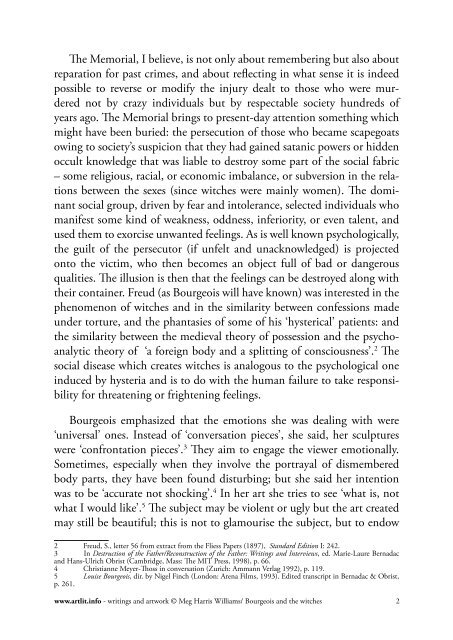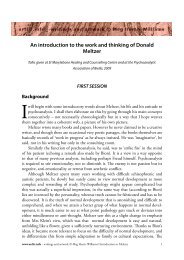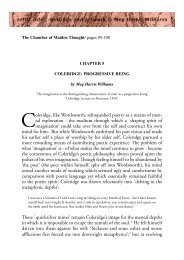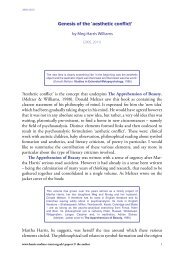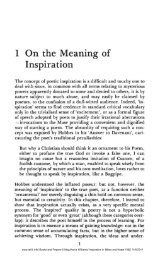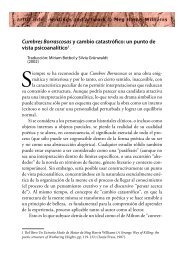Louise Bourgeois and the Witches: the complexity of the ... - Artlit
Louise Bourgeois and the Witches: the complexity of the ... - Artlit
Louise Bourgeois and the Witches: the complexity of the ... - Artlit
You also want an ePaper? Increase the reach of your titles
YUMPU automatically turns print PDFs into web optimized ePapers that Google loves.
The Memorial, I believe, is not only about remembering but also about<br />
reparation for past crimes, <strong>and</strong> about reflecting in what sense it is indeed<br />
possible to reverse or modify <strong>the</strong> injury dealt to those who were murdered<br />
not by crazy individuals but by respectable society hundreds <strong>of</strong><br />
years ago. The Memorial brings to present-day attention something which<br />
might have been buried: <strong>the</strong> persecution <strong>of</strong> those who became scapegoats<br />
owing to society’s suspicion that <strong>the</strong>y had gained satanic powers or hidden<br />
occult knowledge that was liable to destroy some part <strong>of</strong> <strong>the</strong> social fabric<br />
– some religious, racial, or economic imbalance, or subversion in <strong>the</strong> relations<br />
between <strong>the</strong> sexes (since witches were mainly women). The dominant<br />
social group, driven by fear <strong>and</strong> intolerance, selected individuals who<br />
manifest some kind <strong>of</strong> weakness, oddness, inferiority, or even talent, <strong>and</strong><br />
used <strong>the</strong>m to exorcise unwanted feelings. As is well known psychologically,<br />
<strong>the</strong> guilt <strong>of</strong> <strong>the</strong> persecutor (if unfelt <strong>and</strong> unacknowledged) is projected<br />
onto <strong>the</strong> victim, who <strong>the</strong>n becomes an object full <strong>of</strong> bad or dangerous<br />
qualities. The illusion is <strong>the</strong>n that <strong>the</strong> feelings can be destroyed along with<br />
<strong>the</strong>ir container. Freud (as <strong>Bourgeois</strong> will have known) was interested in <strong>the</strong><br />
phenomenon <strong>of</strong> witches <strong>and</strong> in <strong>the</strong> similarity between confessions made<br />
under torture, <strong>and</strong> <strong>the</strong> phantasies <strong>of</strong> some <strong>of</strong> his ‘hysterical’ patients: <strong>and</strong><br />
<strong>the</strong> similarity between <strong>the</strong> medieval <strong>the</strong>ory <strong>of</strong> possession <strong>and</strong> <strong>the</strong> psychoanalytic<br />
<strong>the</strong>ory <strong>of</strong> ‘a foreign body <strong>and</strong> a splitting <strong>of</strong> consciousness’. 2 The<br />
social disease which creates witches is analogous to <strong>the</strong> psychological one<br />
induced by hysteria <strong>and</strong> is to do with <strong>the</strong> human failure to take responsibility<br />
for threatening or frightening feelings.<br />
<strong>Bourgeois</strong> emphasized that <strong>the</strong> emotions she was dealing with were<br />
‘universal’ ones. Instead <strong>of</strong> ‘conversation pieces’, she said, her sculptures<br />
were ‘confrontation pieces’. 3 They aim to engage <strong>the</strong> viewer emotionally.<br />
Sometimes, especially when <strong>the</strong>y involve <strong>the</strong> portrayal <strong>of</strong> dismembered<br />
body parts, <strong>the</strong>y have been found disturbing; but she said her intention<br />
was to be ‘accurate not shocking’. 4 In her art she tries to see ‘what is, not<br />
what I would like’. 5 The subject may be violent or ugly but <strong>the</strong> art created<br />
may still be beautiful; this is not to glamourise <strong>the</strong> subject, but to endow<br />
2 Freud, S., letter 56 from extract from <strong>the</strong> Fliess Papers (1897), St<strong>and</strong>ard Edition I: 242.<br />
3 In Destruction <strong>of</strong> <strong>the</strong> Fa<strong>the</strong>r/Reconstruction <strong>of</strong> <strong>the</strong> Fa<strong>the</strong>r: Writings <strong>and</strong> Interviews, ed. Marie-Laure Bernadac<br />
<strong>and</strong> Hans-Ulrich Obrist (Cambridge, Mass: The MIT Press, 1998), p. 66.<br />
4 Christianne Meyer-Thoss in conversation (Zurich: Ammann Verlag 1992), p. 119.<br />
5 <strong>Louise</strong> <strong>Bourgeois</strong>, dir. by Nigel Finch (London: Arena Films, 1993). Edited transcript in Bernadac & Obrist,<br />
p. 261.<br />
www.artlit.info - writings <strong>and</strong> artwork © Meg Harris Williams/ <strong>Bourgeois</strong> <strong>and</strong> <strong>the</strong> witches 2


